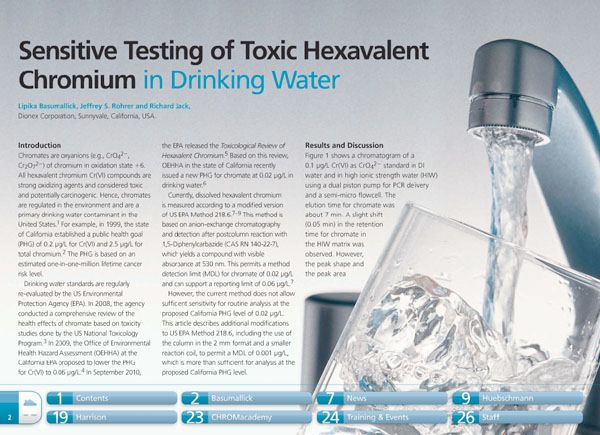Sensitive Testing of Toxic Hexavalent Chromium in Drinking Water
This article describes modifications to US EPA Method 218.6 for detecting dissolved hexavalent chromium in drinking water, to permit a MDL of 0.001 µg/L
Chromates are oxyanions of chromium in oxidation state +6. All hexavalent chromium Cr(VI) compounds are strong oxidizing agents and considered toxic and potentially carcinogenic. Hence, chromates are regulated in the environment and are a primary drinking water contaminant in the United States. For example, in 1999, the state of California established a public health goal (PHG) of 0.2 μg/L for Cr(VI) and 2.5 μg/L for total chromium. The PHG is based on an estimated one-in-one-million lifetime cancer risk level.
Drinking water standards are regularly re‑evaluated by the US Environmental Protection Agency (EPA). In 2008, the agency conducted a comprehensive review of the health effects of chromate based on toxicity studies done by the US National Toxicology Program. In 2009, the Office of Environmental Health Hazard Assessment (OEHHA) at the California EPA proposed to lower the PHG for Cr(VI) to 0.06 μg/L. In September 2010, the EPA released the Toxicological Review of Hexavalent Chromium. Based on this review, OEHHA in the state of California recently issued a new PHG for chromate at 0.02 μg/L in drinking water.
Currently, dissolved hexavalent chromium is measured according to a modified version of US EPA Method 218.6. This method is based on anion-exchange chromatography and detection after postcolumn reaction with 1,5-Diphenylcarbazide (CAS RN 140‑22‑7), which yields a compound with visible absorbance at 530 nm. This permits a method detection limit (MDL) for chromate of 0.02 μg/L and can support a reporting limit of 0.06 μg/L.
However, the current method does not allow sufficient sensitivity for routine analysis at the proposed California PHG level of 0.02 μg/L. This article describes additional modifications to US EPA Method 218.6, including the use of the column in the 2 mm format and a smaller reaction coil, to permit a MDL of 0.001 μg/L, which is more than sufficient for analysis at the proposed California PHG level.

Analytical Challenges in Measuring Migration from Food Contact Materials
November 2nd 2015Food contact materials contain low molecular weight additives and processing aids which can migrate into foods leading to trace levels of contamination. Food safety is ensured through regulations, comprising compositional controls and migration limits, which present a significant analytical challenge to the food industry to ensure compliance and demonstrate due diligence. Of the various analytical approaches, LC-MS/MS has proved to be an essential tool in monitoring migration of target compounds into foods, and more sophisticated approaches such as LC-high resolution MS (Orbitrap) are being increasingly used for untargeted analysis to monitor non-intentionally added substances. This podcast will provide an overview to this area, illustrated with various applications showing current approaches being employed.
New Method Explored for the Detection of CECs in Crops Irrigated with Contaminated Water
April 30th 2025This new study presents a validated QuEChERS–LC-MS/MS method for detecting eight persistent, mobile, and toxic substances in escarole, tomatoes, and tomato leaves irrigated with contaminated water.
University of Tasmania Researchers Explore Haloacetic Acid Determiniation in Water with capLC–MS
April 29th 2025Haloacetic acid detection has become important when analyzing drinking and swimming pool water. University of Tasmania researchers have begun applying capillary liquid chromatography as a means of detecting these substances.

.png&w=3840&q=75)

.png&w=3840&q=75)



.png&w=3840&q=75)



.png&w=3840&q=75)









